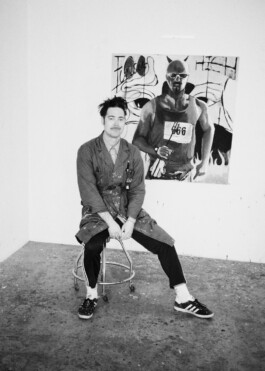
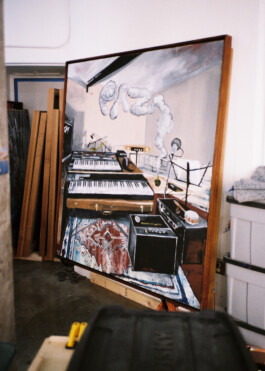
Theodore Boyer
Growing up in a sun-soaked beach town with a shadowy underbelly, Theodore Boyer traded aerospace dreams for art. Now, he’s blending cosmic wonder, raw creativity, and a punk spirit into every piece he creates.
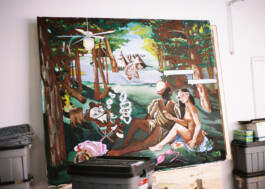
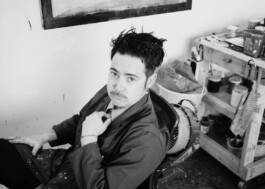
What was life like growing up in Orange County?
Life was good. I describe the town I grew up in as a kind of blue-collar beach community—nice, sunny, and clean on the outside, with a dark, somewhat Lynchian underbelly. Drug trafficking out the back door of local businesses, hobos, drunks, and Nazi Surf Punks. Yes, that was a thing.
You were initially drawn to engineering and space—how did that interest evolve into a visual art practice?
There was a Navy base, and Boeing was there—previously McDonnell Douglas. Several of my friends' parents worked for these companies and/or lived on the Navy base. So, engineering, aerospace, and the military were always in my peripheral vision as something to do after school. There were always rumors floating around about secret advanced technology and bizarre aerial phenomena happening in the area where I grew up, so I naturally had a curiosity about what was going on.
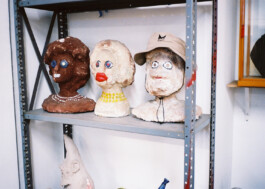
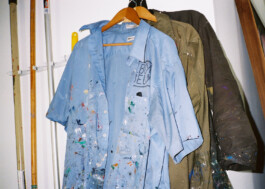
“The fascination with celestial themes is an ongoing development—I don’t think it can ever be completely understood in a human lifetime.”
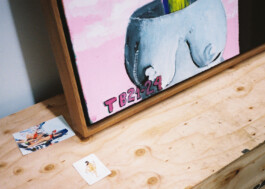
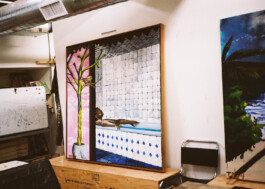
Your work is deeply rooted in cosmic and celestial themes. When did this fascination begin for you?
I was always interested in the metaphysical from a very early age. When I finished art school in New York, I was in my studio experimenting with materials. Once I started to let go of what I was trying to do, I realized the material reacted in a certain way depending on the elements and gravity. The forms started to resemble surfaces of the Earth from an aerial perspective. When I switched to dye, I noticed the same type of reaction happening—the elements doing their thing—and the formations became a reflection of the opposite perspective. It was an "as above, so below" aha moment. That discovery laid the groundwork for pretty much everything that followed.
Each painting still starts with the abstract process of laying down dye on raw canvas and allowing chance and nature to take part in the process with me. The fascination with celestial themes is an ongoing development—I don’t think it can ever be completely understood in a human lifetime. Once I started introducing figures into the paintings, it reinforced the concept that everything outside the human body exists inside as well. We’re all made of the same elements as our sun, just molecularly organized differently, so in a way, we’re all part of the same thing.
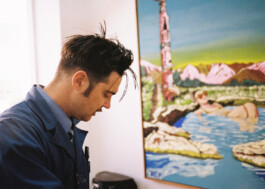

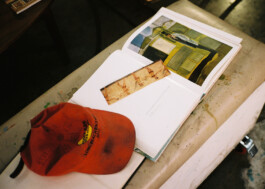
You’ve spoken about how travel has shaped your practice. Is there a particular place or experience that had a lasting impact on your artistic vision?
I think, in general, travel is paramount to my art because it informs and inspires things I normally wouldn’t think about or notice. Over the years, I’ve discovered many different methods, techniques, insights, ideas, and philosophies through travel.
What about a specific piece of art—has there been one that felt especially transformative?
You know what? I can’t say a specific piece of art was transformative per se, but once I saw Raymond Pettibon in the MoMA, I was hooked on art. Seeing his work in the museum made me believe that if he could do it, I could too.
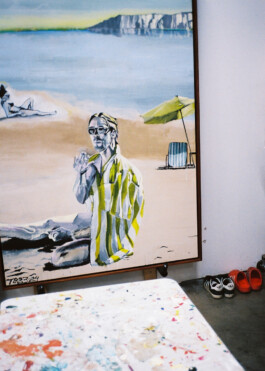

How much of your creative process do you feel is driven by the subconscious? Do you actively try to tap into that space when creating?
Lately, almost everything I do is informed by the subconscious. I believe that this is our true self, and to create great art, you really have to know that part of yourself—and ask it what to do.
Some intriguing characters appear in your work—who are they?!
Most of the characters are people I know or have known over the years. Sometimes, I incorporate contemporary cartoons that shaped my consciousness as a child.
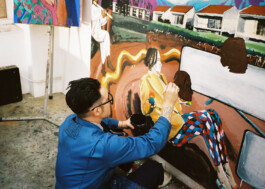
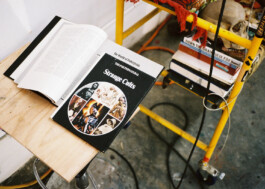
Any recent moments of insight or "enlightenment"?
Every day, I try to have a moment of insight or enlightenment. From my experience, the way to channel that information is by being open to it and trying not to think too much. Everyone is born with a creative spark—it’s just a matter of being aware of it and listening to it.
How has your personal style evolved over the years?
When I was younger, I was really inspired by people who just looked different. I was adopted, and my parents were pretty conventional, so when I saw punks on the street or on TV, I was always curious about counterculture and underground movements. As I grew older, music and art influenced my style and attitude, and I started opening up to different ideas, philosophies, and genres of music and art. All of these things have shaped my current style—artistically and otherwise.
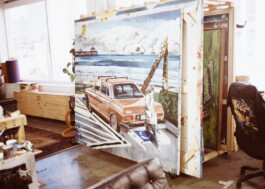
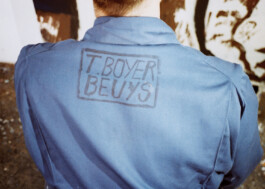
“To create great art, you really have to know that part of yourself—and ask it what to do.”
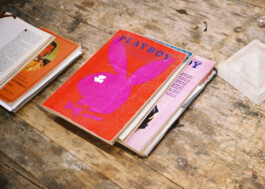
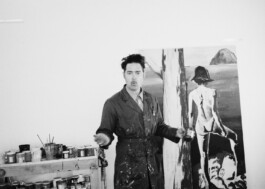
Looking ahead, are there any new concepts or mediums you’re excited to experiment with?
Right now, I’m working on a podcast with my friend Jesse Camp, where we interview other artists while I paint their portraits. We’ve just finished filming the first few episodes and are now editing them. His brand of comedy meshes well with the core theme of the show—how art and spirituality are synonymous, rooted in the idea that the artist is a conduit for spiritual manifestation. The podcast is called Art Show.
I think film is the medium of today’s age with the greatest potential to influence people.
What’s playing in the studio right now?
Blur.
Is Costa Mesa calling?
Always!

Theodore Boyer

Growing up in a sun-soaked beach town with a shadowy underbelly, Theodore Boyer traded aerospace dreams for art. Now, he’s blending cosmic wonder, raw creativity, and a punk spirit into every piece he creates.


What was life like growing up in Orange County?
Life was good. I describe the town I grew up in as a kind of blue-collar beach community—nice, sunny, and clean on the outside, with a dark, somewhat Lynchian underbelly. Drug trafficking out the back door of local businesses, hobos, drunks, and Nazi Surf Punks. Yes, that was a thing.
You were initially drawn to engineering and space—how did that interest evolve into a visual art practice?
There was a Navy base, and Boeing was there—previously McDonnell Douglas. Several of my friends' parents worked for these companies and/or lived on the Navy base. So, engineering, aerospace, and the military were always in my peripheral vision as something to do after school. There were always rumors floating around about secret advanced technology and bizarre aerial phenomena happening in the area where I grew up, so I naturally had a curiosity about what was going on.


“The fascination with celestial themes is an ongoing development—I don’t think it can ever be completely understood in a human lifetime.”


Your work is deeply rooted in cosmic and celestial themes. When did this fascination begin for you?
I was always interested in the metaphysical from a very early age. When I finished art school in New York, I was in my studio experimenting with materials. Once I started to let go of what I was trying to do, I realized the material reacted in a certain way depending on the elements and gravity. The forms started to resemble surfaces of the Earth from an aerial perspective. When I switched to dye, I noticed the same type of reaction happening—the elements doing their thing—and the formations became a reflection of the opposite perspective. It was an "as above, so below" aha moment. That discovery laid the groundwork for pretty much everything that followed.
Each painting still starts with the abstract process of laying down dye on raw canvas and allowing chance and nature to take part in the process with me. The fascination with celestial themes is an ongoing development—I don’t think it can ever be completely understood in a human lifetime. Once I started introducing figures into the paintings, it reinforced the concept that everything outside the human body exists inside as well. We’re all made of the same elements as our sun, just molecularly organized differently, so in a way, we’re all part of the same thing.



You’ve spoken about how travel has shaped your practice. Is there a particular place or experience that had a lasting impact on your artistic vision?
I think, in general, travel is paramount to my art because it informs and inspires things I normally wouldn’t think about or notice. Over the years, I’ve discovered many different methods, techniques, insights, ideas, and philosophies through travel.
What about a specific piece of art—has there been one that felt especially transformative?
You know what? I can’t say a specific piece of art was transformative per se, but once I saw Raymond Pettibon in the MoMA, I was hooked on art. Seeing his work in the museum made me believe that if he could do it, I could too.


How much of your creative process do you feel is driven by the subconscious? Do you actively try to tap into that space when creating?
Lately, almost everything I do is informed by the subconscious. I believe that this is our true self, and to create great art, you really have to know that part of yourself—and ask it what to do.
Some intriguing characters appear in your work—who are they?!
Most of the characters are people I know or have known over the years. Sometimes, I incorporate contemporary cartoons that shaped my consciousness as a child.


Any recent moments of insight or "enlightenment"?
Every day, I try to have a moment of insight or enlightenment. From my experience, the way to channel that information is by being open to it and trying not to think too much. Everyone is born with a creative spark—it’s just a matter of being aware of it and listening to it.
How has your personal style evolved over the years?
When I was younger, I was really inspired by people who just looked different. I was adopted, and my parents were pretty conventional, so when I saw punks on the street or on TV, I was always curious about counterculture and underground movements. As I grew older, music and art influenced my style and attitude, and I started opening up to different ideas, philosophies, and genres of music and art. All of these things have shaped my current style—artistically and otherwise.


“To create great art, you really have to know that part of yourself—and ask it what to do.”

Looking ahead, are there any new concepts or mediums you’re excited to experiment with?
Right now, I’m working on a podcast with my friend Jesse Camp, where we interview other artists while I paint their portraits. We’ve just finished filming the first few episodes and are now editing them. His brand of comedy meshes well with the core theme of the show—how art and spirituality are synonymous, rooted in the idea that the artist is a conduit for spiritual manifestation. The podcast is called Art Show.
I think film is the medium of today’s age with the greatest potential to influence people.
What’s playing in the studio right now?
Blur.
Is Costa Mesa calling?
Always!
